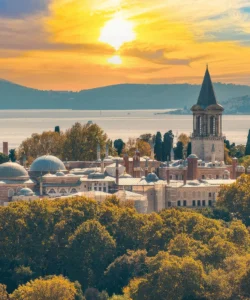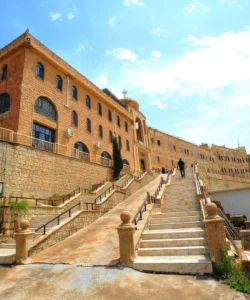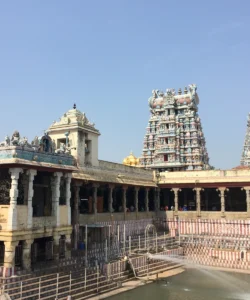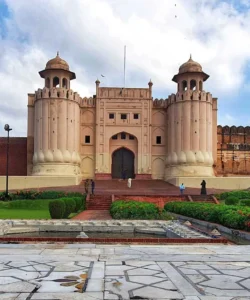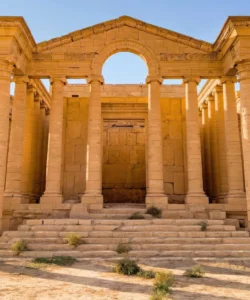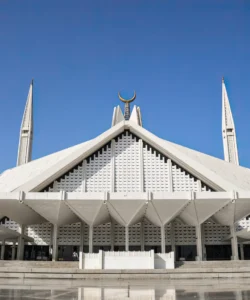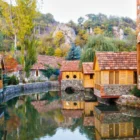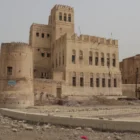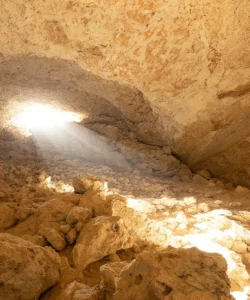Etchmiadzin Cathedral (Armenian: Էջմիածնի Մայր Տաճար, Ēǰmiaçni mayr tač̣ar), also known as the Mother Cathedral of Holy Etchmiadzin, is the pre-eminent spiritual and administrative center of the Armenian Apostolic Church. It is located in the city dually known as Etchmiadzin (Ejmiatsin) and Vagharshapat, Armenia. Often regarded as the oldest cathedral in the world, it holds unparalleled significance in the history of Christianity.
Listen to an introduction about Etchmiadzin Cathedral
Name and Address
- Name: Etchmiadzin Cathedral (also commonly referred to as Mother Cathedral of Holy Etchmiadzin, Holy Etchmiadzin, or simply Etchmiadzin). The name “Etchmiadzin” literally means “the descent of the Only Begotten,” referring to a vision Saint Gregory the Illuminator had of Jesus Christ descending to indicate the site for the cathedral.
- Address: Araratyan Street, 1, Vagharshapat (Etchmiadzin), Armavir Province, Armenia.
- Location: Situated approximately 20-25 kilometers (12-15 miles) west of Yerevan, making it a highly accessible pilgrimage and tourist destination. The cathedral complex is at the heart of the Mother See of Holy Etchmiadzin, which includes the residence of the Catholicos of All Armenians.
How to Get There
Etchmiadzin Cathedral is a very popular and easy day trip from Yerevan:
- By Car/Taxi: A quick and convenient 20-30 minute drive from Yerevan. Taxis and ride-sharing services are readily available.
- By Public Bus/Minibus (Marshrutka): Buses and minibuses (e.g., #202 or #203) depart frequently (every 10 minutes) from Yerevan’s Kilikia Central Bus Station (also known as Sasuntsi Davit Train Station area) directly to Etchmiadzin. The journey takes about 30-50 minutes, and the final stop is just a few steps from the cathedral.
- By Train: An electric train runs from Yerevan’s Central Railway Station to Etchmiadzin a few times a day, taking around 30-35 minutes. Note that the Etchmiadzin train station is about 15 km from the city center, so a short taxi ride would be needed to reach the cathedral.
- Organized Tours: Many tour operators offer combined half-day or full-day tours from Yerevan that include Etchmiadzin Cathedral, often with other nearby historical sites like Zvartnots Cathedral.
Landscape and Architecture
Etchmiadzin Cathedral is a living testament to centuries of Armenian architectural evolution, though its core dates back to the very beginnings of Christian architecture.
- Foundation: Traditionally, the original cathedral was built between 301-303 AD by Saint Gregory the Illuminator on the site of a pagan temple, making it the first cathedral built in ancient Armenia and often considered the world’s oldest Christian cathedral.
- Architectural Style: Over centuries of renovations and additions, the cathedral’s exterior presents a rich mix of Armenian architectural and artistic styles. Its fundamental design is a central-domed, cruciform shape (a Greek cross with four projecting apses and a central dome supported by four pillars), which became a highly influential model for later Armenian churches.
- Key Features:
- Dome and Belfry: The current dome was completed in the 17th century, and a belfry was added in 1654-1658. The dome, influenced by Safavid Persian architecture during a period of Persian control, features distinctive elements.
- Interior: The interior boasts frescoes, some from the 18th century by the Hovnatanian family, depicting biblical stories and saints.
- Materials: Constructed primarily from local tuff stone, giving it a sturdy and enduring quality.
- Surrounding Complex: The cathedral is part of a larger walled complex that includes several other churches (like St. Gayane, St. Hripsime, St. Shoghakat), a theological seminary, a museum (Treasury Museum), a Catholicos’ residence, and various administrative buildings and monastic structures.
- Landscape: The cathedral is located in a relatively flat plain, offering views of the distant Mount Ararat, a symbolic backdrop for many Armenian sacred sites. The complex is surrounded by well-maintained gardens and courtyards, contributing to a serene and spiritual atmosphere.
What Makes It Famous
Etchmiadzin Cathedral’s fame is deeply rooted in its unparalleled historical, religious, and architectural significance:
- World’s Oldest Cathedral: It is widely recognized as the first cathedral built in ancient Armenia and often regarded as the oldest Christian cathedral in the world, symbolizing Armenia’s pioneering role as the first nation to adopt Christianity as a state religion in 301 AD.
- Mother See of Armenian Apostolic Church: It serves as the spiritual and administrative headquarters of the Armenian Apostolic Church worldwide, akin to the Vatican for Roman Catholics.
- Sacred Relics: The Treasury Museum within the complex houses highly revered Christian relics, including a piece of Noah’s Ark, the Holy Lance (which allegedly pierced Christ’s side during the Crucifixion, previously housed at Geghard Monastery), and the hand of Saint Gregory the Illuminator. These relics make it a major pilgrimage site.
- UNESCO World Heritage Site: It was designated a UNESCO World Heritage Site in 2000, along with the archaeological site of Zvartnots, for its profound influence on the development of Armenian ecclesiastical architecture and its testimony to the implantation of Christianity in Armenia.
- Symbol of Armenian Identity: Beyond its religious role, Etchmiadzin is a powerful symbol of Armenian national identity, resilience, and cultural heritage.
Differences from Some Other Landmarks
Etchmiadzin Cathedral, while a central pilgrimage site, differs from other Armenian landmarks in several ways:
- Primacy: Unlike other Armenian monasteries, Etchmiadzin holds the unique distinction of being the mother church and the seat of the Catholicos of All Armenians, making it the supreme spiritual authority of the Armenian Apostolic Church.
- Architectural Influence: While sites like Zvartnots demonstrate architectural innovation, Etchmiadzin’s enduring significance lies in its foundational role in establishing a distinct Armenian church architectural style (the central-domed cruciform plan) that profoundly influenced later religious constructions across the region.
- Comprehensive Complex: It is not just a single church or monastery but a vast complex that embodies the entire administrative and spiritual leadership of a global church, including seminaries, museums, and residences, making it a living, active religious city.
- Location and Accessibility: Located in a bustling city rather than a remote natural setting (like Geghard or Tatev), Etchmiadzin is more easily accessible for daily visits, offering a different kind of experience that balances pilgrimage with urban life.
Etchmiadzin Cathedral Photos:


































